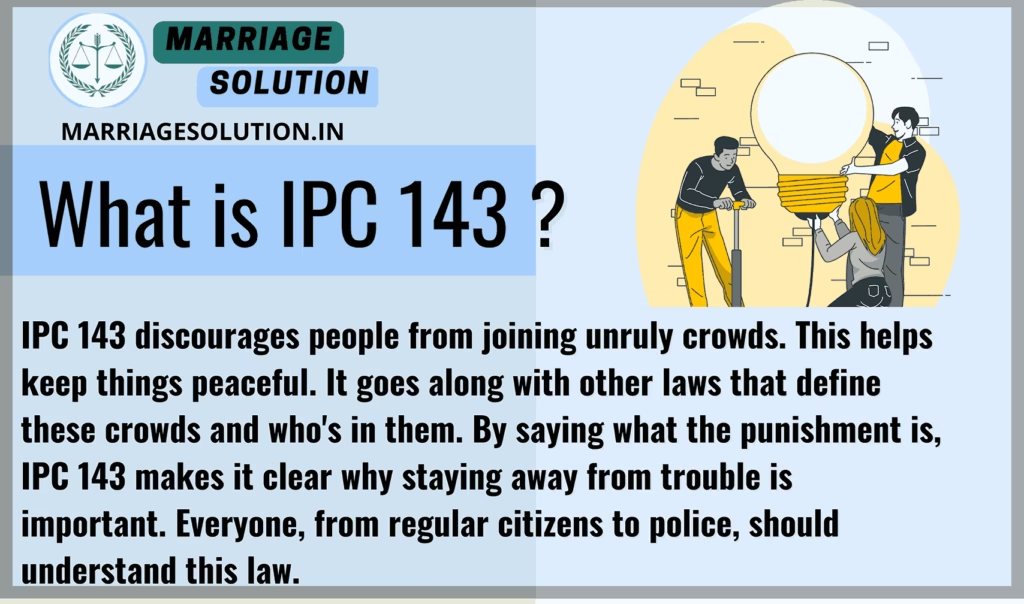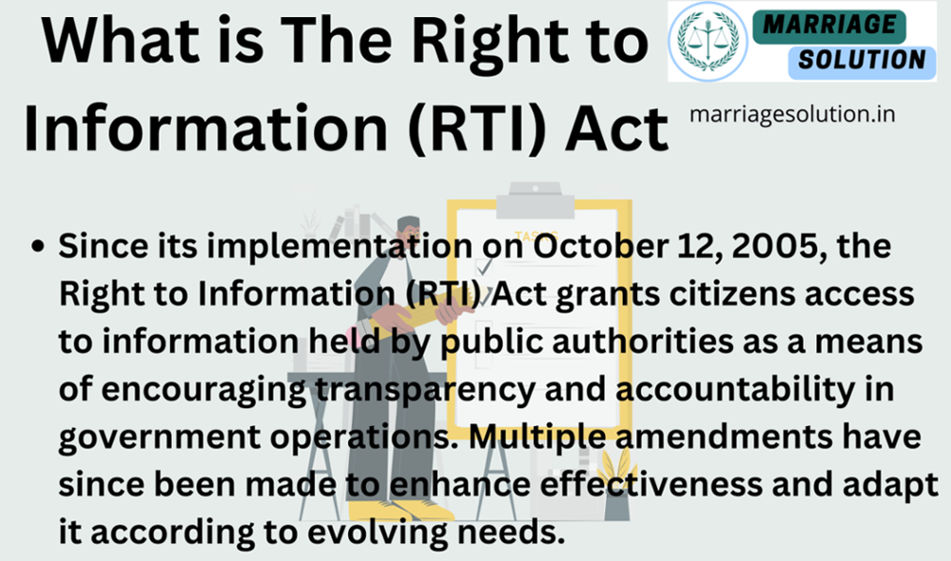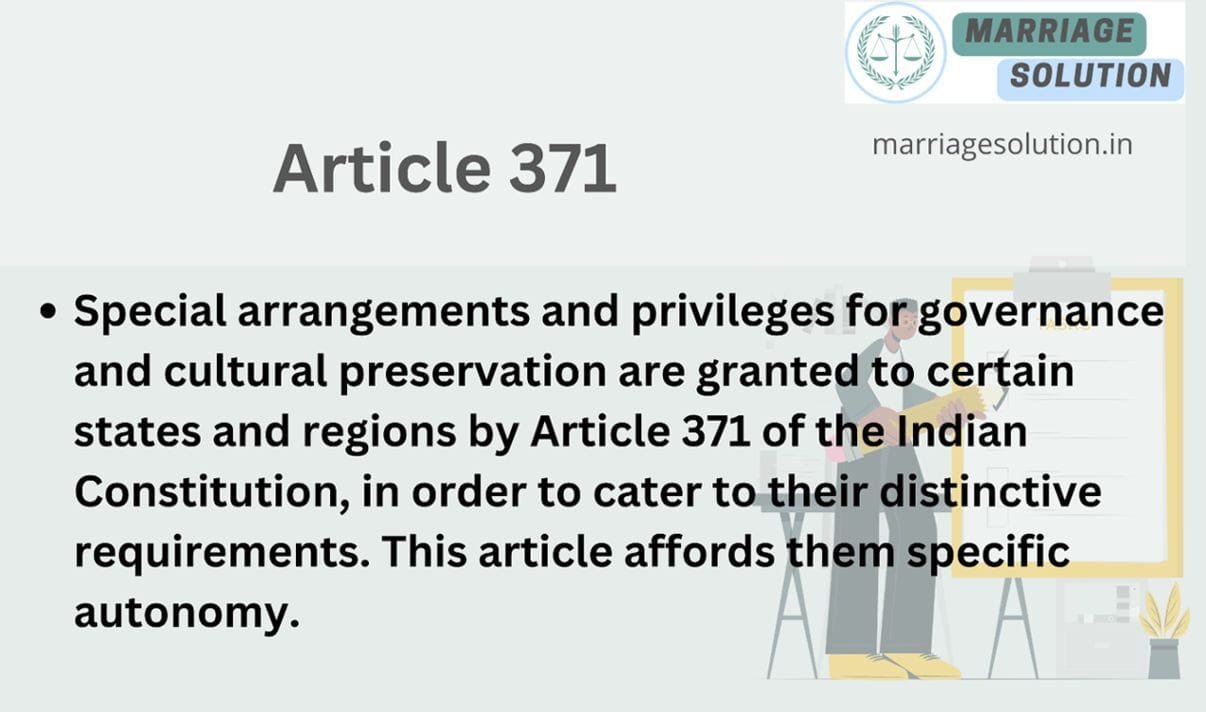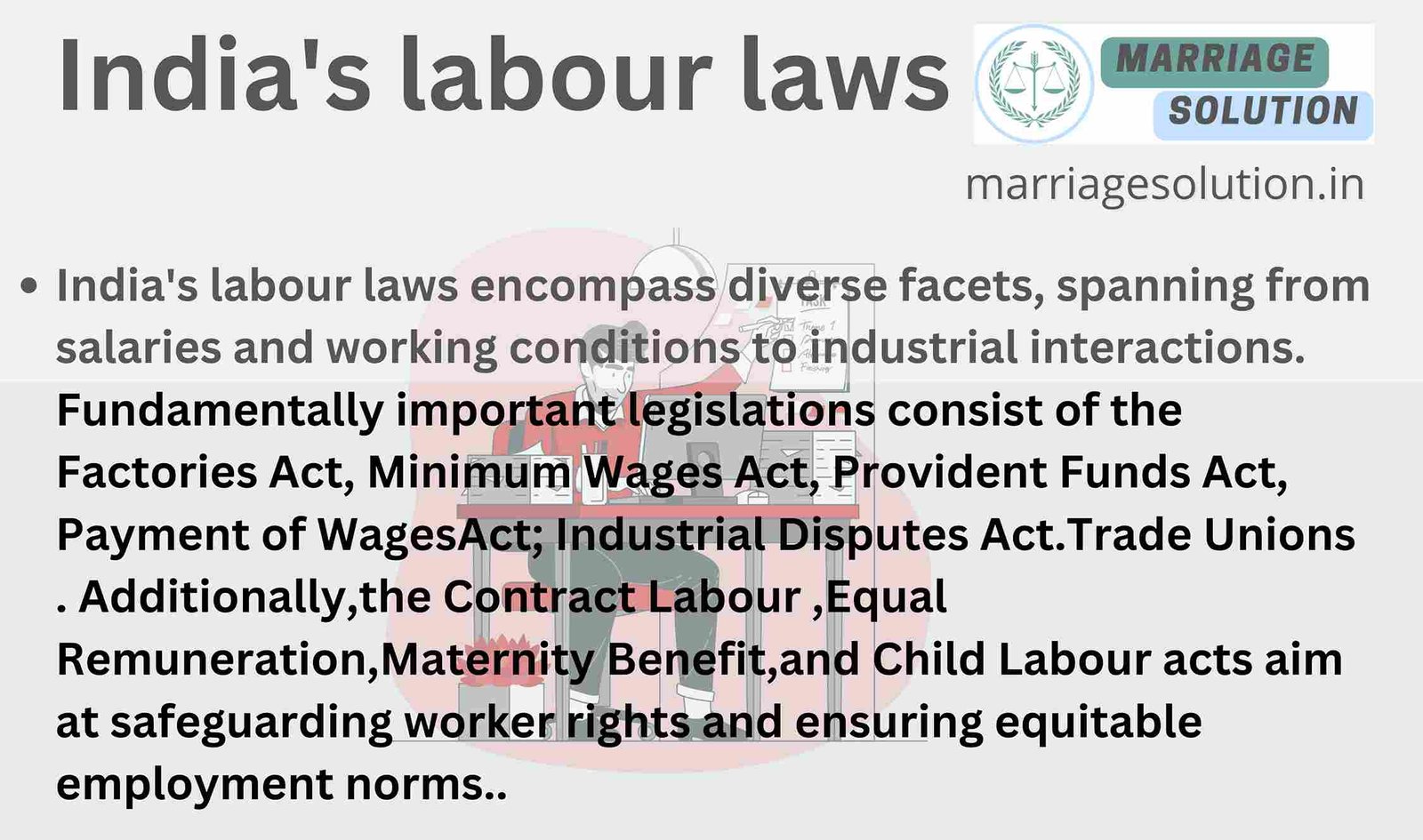Introduction of IPC 143
IPC 143 of the Indian Penal Code (IPC) deals with punishing people who are members of an unlawful assembly. It helps maintain public order by discouraging people from joining groups that might turn violent or disruptive. This section works with Sections 141 and 142, which explain what an unlawful assembly is and who is considered a member. IPC 143 provides the punishment for being part of such an assembly. Understanding this law is important for everyone to know the consequences of participating in unlawful gatherings.
- Introduction of IPC 143
- What is IPC Section 143 ?
- Section 143 IPC in Simple Points
- IPC Section 143 Overview
- 10 Key Points of IPC 143 (Explained in Detail)
- 1. Connection to IPC 141 and 142
- 2. Who Can Be Punished Under IPC 143?
- 3. Knowledge and Intent Are Important
- 4. Collective Responsibility of Members
- 5. Purpose of IPC 143 – Preventing Unlawful Assemblies
- 6. Discretionary Power of Courts
- 7. Proof Required for Conviction
- 8. Right to Assembly vs. Unlawful Assembly
- 9. Additional Charges Along with IPC 143
- 10. Punishment Under IPC 143
- Examples of IPC 143
- 10 Key Points of IPC 143 (Explained in Detail)
- IPC 143 Punishment
- 143 IPC bailable or not ?
- Section 143 IPC case laws
- Section 143 IPC in short information
- 143 IPC FAQs
- If you need support with court proceedings or any other legal matters, don’t hesitate to reach out for assistance.
What is IPC Section 143 ?
IPC 143 discourages people from joining unruly crowds. This helps keep things peaceful. It goes along with other laws that define these crowds and who’s in them. By saying what the punishment is, IPC 143 makes it clear why staying away from trouble is important. Everyone, from regular citizens to police, should understand this law.

Section 143 IPC in Simple Points
1. IPC 143 Punishes Membership in an Unlawful Assembly
IPC 143 applies to anyone who is a member of an unlawful assembly. It does not matter if the person is a leader or a follower—if they are knowingly part of the group, they can be punished. The law ensures that people do not support or encourage unlawful gatherings that may disturb public peace.
2. Knowledge and Intent Are Important
To be guilty under IPC 143, the person must know that the assembly is unlawful and still choose to stay. If a person unknowingly joins the group, they are not guilty. However, if they realize it is illegal and still continue, they can be punished under this section.
3. Punishment Under IPC 143
A person convicted under IPC 143 can face:
- Up to 6 months in jail OR
- A fine OR
- Both imprisonment and fine
This punishment is meant to deter people from joining unlawful assemblies and maintain law and order.
4. IPC 143 is Bailable and Non-Cognizable
IPC 143 is a bailable and non-cognizable offence. This means:
- The accused can get bail easily.
- The police cannot arrest without permission from the court.
This ensures that minor offenders do not face harsh treatment but still face legal consequences.
5. IPC 143 Can Apply with Other Charges
If an unlawful assembly commits serious crimes like rioting, arson, or violence, its members can also be charged under other sections of IPC. For example:
- If the assembly destroys property, IPC 427 (mischief) applies.
- If they attack someone, IPC 323 (causing hurt) applies.
This ensures strict punishment for those involved in crimes beyond just unlawful assembly.
IPC Section 143 Overview
IPC 143 is meant to discourage people from joining or staying in groups with illegal intentions. It acts as a warning that joining troublemakers can lead to legal trouble. This law helps keep public spaces safe by making people think twice before joining a problematic crowd.
Key-Points
10 Key Points of IPC 143 (Explained in Detail)
1. Connection to IPC 141 and 142
IPC 143 is closely linked to IPC 141 and IPC 142. IPC 141 defines an unlawful assembly, IPC 142 explains who is considered a member, and IPC 143 provides punishment for being a part of it. This section ensures that people who knowingly join such gatherings face legal consequences. Understanding all three sections is necessary to know how the law deals with unlawful assemblies.
2. Who Can Be Punished Under IPC 143?
Any person found to be a member of an unlawful assembly can be punished under IPC 143. It does not matter whether the person was actively committing a crime or just present in the gathering—if they knowingly participated in an unlawful assembly, they are guilty under this section.
3. Knowledge and Intent Are Important
For IPC 143 to apply, the person must know that the assembly is unlawful and still choose to be part of it. For example, if a group is gathering to attack someone, and a person joins them knowing their intent, they are guilty. However, if someone is present accidentally or unknowingly, they cannot be punished under this section.
4. Collective Responsibility of Members
IPC 143 follows the principle of collective responsibility, meaning that all members of an unlawful assembly share equal liability for the group’s actions. Even if a person did not personally commit any violence, their presence in the assembly makes them responsible.
5. Purpose of IPC 143 – Preventing Unlawful Assemblies
This law acts as a deterrent to stop people from joining unlawful gatherings. It discourages individuals from becoming part of mobs, riots, or other illegal assemblies, ensuring that people think twice before participating in such acts.
6. Discretionary Power of Courts
Judges have the power to decide the punishment based on the situation. They can consider factors such as:
- Whether the person was actively involved
- Whether they were a first-time offender
- The seriousness of the unlawful act
This ensures that punishments are fair and appropriate.
7. Proof Required for Conviction
To punish someone under IPC 143, the prosecution must prove two things:
- The person was part of an unlawful assembly
- The person knew the assembly was unlawful
It is not enough to simply be in the area; there must be clear evidence of intentional participation.
8. Right to Assembly vs. Unlawful Assembly
The Indian Constitution gives citizens the right to assemble peacefully under Article 19(1)(b). However, IPC 143 ensures that this right is not misused for criminal activities. A peaceful protest is legal, but if it turns violent, it can become an unlawful assembly.
9. Additional Charges Along with IPC 143
If an unlawful assembly commits a crime like rioting, arson, or assault, members can be charged under additional sections along with IPC 143. For example, if a mob destroys public property, they can also be charged under IPC 427 (mischief causing damage).
10. Punishment Under IPC 143
The punishment for being a member of an unlawful assembly under IPC 143 is:
- Imprisonment of up to 6 months OR
- A fine OR
- Both imprisonment and fine
This ensures that people avoid joining unlawful gatherings to prevent legal consequences.
Examples of IPC 143
Example 1: Protest Turning Violent
A group of people gathers to protest peacefully against a government policy. Suddenly, some members start damaging public property and attacking police officers. If a person remains in the group knowingly, they can be charged under IPC 143, even if they did not personally cause damage.
Example 2: Mob Attacking a Shop
A mob gathers outside a shop, accusing the owner of cheating customers. The group then starts breaking windows and looting goods. Even if someone in the group did not steal anything but was knowingly part of the gathering, they can be punished under IPC 143 for being a member of an unlawful assembly.
IPC 143 Punishment
Imprisonment: If you’re found guilty under IPC 143, you could be imprisoned for up to six months.
Fine: Along with or instead of jail time, the court can also impose a fine.

143 IPC bailable or not ?
IPC 143 is generally a bailable offense. This means if you’re arrested under this section, you can be released on bail. The police or court can grant bail without you having to appear before a judge first. However, if the unlawful assembly led to more serious crimes, those additional charges might not be bailable. So while IPC 143 itself is bailable, the overall situation could be more complex.
Section 143 IPC case laws
IPC 143: Important Case Laws and Their Judgments
1. Kedar Nath Singh v. State of Bihar (1962)
Case Facts:
- Kedar Nath Singh, a political leader, gave a speech criticizing the government.
- His speech led to a large gathering, where some members became violent.
- The police charged him and others under IPC 143 for being part of an unlawful assembly.
Judgment & Result:
- The Supreme Court ruled that mere speech is not unlawful assembly unless it incites violence.
- Since the violence was not proven to be directly linked to him, Kedar Nath Singh was not guilty under IPC 143.
- This case clarified that a person must be knowingly and actively part of an unlawful assembly to be punished.
2. State of Maharashtra v. Ramlal Devappa Rathod (2015)
Case Facts:
- A group of villagers gathered to protest against a land acquisition.
- The protest turned violent, and some members set government vehicles on fire.
- Several villagers were arrested under IPC 143 for being members of the unlawful assembly.
Judgment & Result:
- The court held that everyone present in the unlawful assembly is responsible, even if they did not directly cause damage.
- The accused were convicted under IPC 143 and sentenced to 3 months imprisonment with a fine.
- This case reaffirmed the principle of collective responsibility under IPC 143.
3. Manjit Singh v. State of Punjab (2009)
Case Facts:
- A religious procession turned into a violent mob that clashed with another group.
- Several people were injured, and public property was damaged.
- Manjit Singh was arrested under IPC 143 as he was part of the gathering.
Judgment & Result:
- The court observed that mere presence in a crowd is not enough for conviction.
- Since Manjit Singh did not actively support or participate in violence, he was acquitted.
- This case emphasized that prosecution must prove intention and awareness before convicting under IPC 143.
4. Mohd. Shafi v. State of Rajasthan (2012)
Case Facts:
- A group of workers gathered outside a factory demanding wages.
- The protest became aggressive, and some workers forcibly entered the factory and attacked employees.
- Several protesters were arrested under IPC 143.
Judgment & Result:
- The court ruled that if a peaceful assembly turns unlawful, those who continue to stay are responsible under IPC 143.
- The accused were convicted and sentenced to 2 months in jail with a fine.
- The court stated that even passive members are guilty if they do not leave when the assembly turns unlawful.
5. State of Tamil Nadu v. V. Shankar (2018)
Case Facts:
- A political rally turned violent when some members started throwing stones at police officers.
- V. Shankar, a party member, was arrested under IPC 143 for being part of the unlawful assembly.
Judgment & Result:
- The court found that Shankar was aware of the violence but did not leave the assembly.
- He was convicted under IPC 143 and sentenced to 1 month in jail.
- The judgment reinforced that knowledge and continued presence in an unlawful assembly are punishable.
Section 143 IPC in short information
| IPC Section | Offense | Punishment | Bailable/Non-Bailable | Cognizable/Non-Cognizable | Trial By |
|---|---|---|---|---|---|
| IPC 143 | Being a member of an unlawful assembly | Up to 6 months in jail or fine or both | Bailable | Non-Cognizable | Magistrate |
143 IPC FAQs
What is IPC 143?
IPC 143 deals with the punishment for being part of a group planning to cause trouble. It discourages people from joining these gatherings to keep public spaces safe.
How can I get in trouble under IPC 143?
You can be charged if you’re part of a group of at least five people who intend to do something illegal. Just being present and aware of the group’s purpose can be enough.
What is the punishment for IPC 143?
The punishment can be up to 6 months in jail, a fine, or both. The severity depends on how involved you were and the seriousness of the situation.
If you need support with court proceedings or any other legal matters, don’t hesitate to reach out for assistance.
Court or any other marriage-related issues, our https://marriagesolution.in/lawyer-help-1/ website may prove helpful. By completing our enquiry form and submitting it online, we can provide customized guidance to navigate through the process effectively. Don’t hesitate to contact us for personalized solutions; we are here to assist you whenever necessary!
Right to Information RTI act :Your Comprehensive Guide (Part 1)
The Right to Information (RTI) Act : Explore the essence of the Right to Information (RTI) Act through this symbolic image. The image features legal documents, emphasizing the importance of transparency and accountability in governance. The scales of justice represent…
What is Article 371 of Indian Constitution ?
Article 371 of the Indian Constitution grants special provisions to specific states and regions within India, addressing their unique historical, social, and cultural circumstances. These provisions aim to accommodate diverse needs and protect cultural identities within the constitutional framework.
Indian Labour law : Your Comprehensive Guide (Part 1)
The purpose of labour laws is to safeguard employees and guarantee equitable treatment at the workplace, encompassing aspects such as remuneration, security, and perks. These regulations establish a secure ambiance by imposing minimum wage requirements, ensuring factory safety measures are…
GST :Your Comprehensive Guide (Part 1 – Understanding the Basics)
The Goods and Services Tax (GST) is like a big change in how we pay taxes in India. It started on July 1, 2017, and it’s here to simplify things. Before GST, we had many different taxes, and it could…





